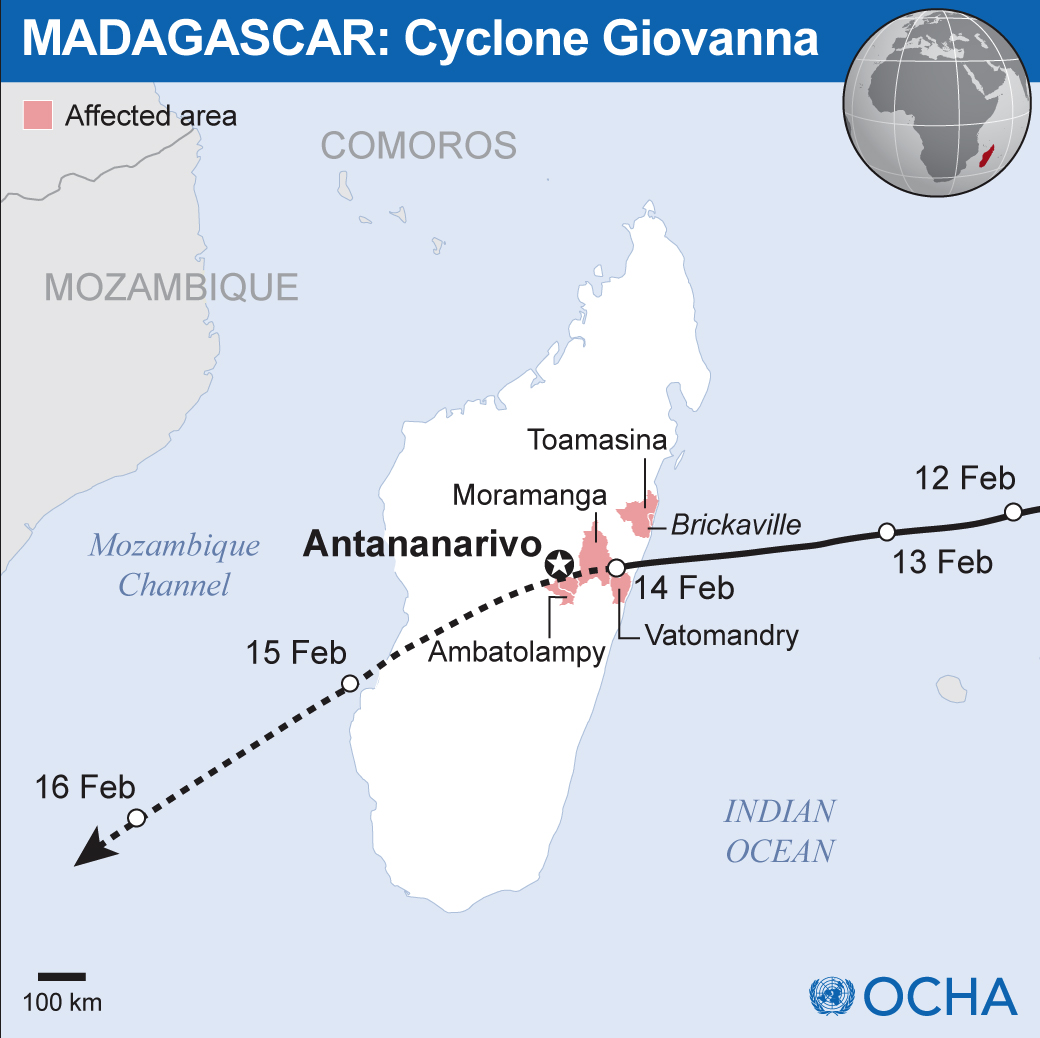The cyclone made landfall in the early hours of 14 February south of the port town of Toamasina and then carved a path through heavily populated areas towards the capital, Antananarivo, reportedly uprooting trees, damaging infrastructure, causing landslides and flooding as it moved inland.
The National Disaster Risk Management Agency (BNGRC) has reportedly confirmed 10 deaths caused by the cyclone in the first 24 hours or so.
The NGO, Care International, the disaster relief office of the US embassy, the faith-based NGO Medair, and the UN Children’s Agency (UNICEF) have all begun or scheduled aerial surveillance of the affected east coast region, “so that we can understand the exact dimensions of this natural disaster,” Dominic Stolarow, UNICEF emergency coordinator in Madagascar, said in a statement on 14 February.
The cyclone’s intensity had decreased by the time it reached Antananarivo, but winds of about 180km/h whipped through the capital, interrupting electricity and water supplies and tearing down billboards. Several houses collapsed, although there were no reports of casualties. Cyclone warning broadcasts by Malagasy state radio were interrupted for extended periods.
“The [helicopter] team informs us that Brickaville, the district capital closest to the point of landfall of Giovanna, was seriously hit - 70 percent of dwellings were destroyed or damaged to the point of being uninhabitable. Care staff on the ground also report 60 percent of structures damaged or destroyed in the district capital of Vatomandry, 60 kilometres further south,” Care International country director John Uniack Davis told IRIN.
The combined population of Brickaville and Vatomandry districts is about 400,000.
“The populations will definitely require government and international assistance to get back on their feet and we will have a better sense of this in coming days,” Uniack Davis said. “Our initial impressions are that Cyclone Giovanna damage doesn’t cover a vast area, but some areas are quite hard hit, especially the districts of Brickaville and Vatomandry.”
The Office for the Coordination of Humanitarian Affairs (OCHA) said in a 14 February situation report that the cyclone’s impact was expected to be “severe” along the eastern coast, but communications in Brickaville and Vatomandry, and “with other districts in the same area, have been cut off.”
“The distribution of food and relief supplies will commence as soon as Giovanna has passed, depending of the nature and the intensity of damage and accessibility of the affected areas,” OCHA said.
Regional impact
A briefing note by the regional economic bloc - the Southern African Development Community (SADC) Climate Services Centre; Tropical cyclone Giovanna and the expected rainfall situation across SADC from 15 February to 1 March 2012 - noted that “Current track and intensity forecasts have briefly strengthening Giovanna over the [Mozambique] Channel before [a] weakening again and making a second landfall across southern Mozambique on the 18 February.
“In particular, there should be more persistent rains across the parts of the north and central areas of contiguous SADC and Madagascar for the next several days. This should quite likely exacerbate the problems of localized flooding that have affected portions of Malawi, Mozambique, Zambia and Zimbabwe,” the briefing said.
About 40 people died and more than 100,000 were affected when twin storms hit Mozambique between 18 and 26 January.
Tropical Cyclone Funso struck northern Mozambique, affecting about 65,000 people, causing floods and damage to houses, schools and health centres, while in southern Mozambique heavy rainstorms from tropical storm Dando affected about 52,000 people.
go/he
This article was produced by IRIN News while it was part of the United Nations Office for the Coordination of Humanitarian Affairs. Please send queries on copyright or liability to the UN. For more information: https://shop.un.org/rights-permissions




